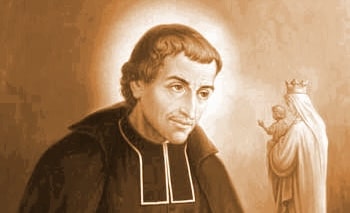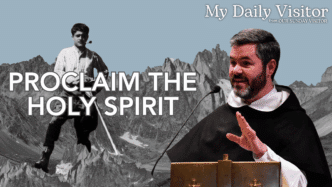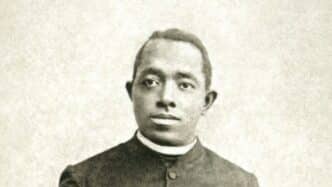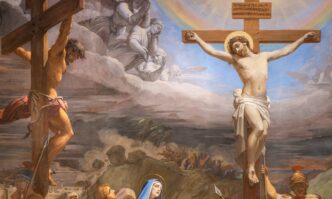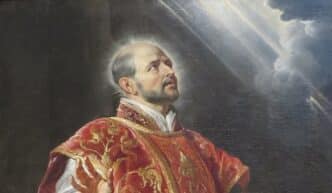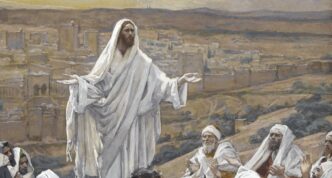In coming years, some Roman pilgrims will undoubtedly search for Pope Francis’ tomb at St. Peter’s Basilica only to learn that, in accord with the pontiff’s wishes, his mortal remains are actually located at St. Mary Major Basilica. It’s a place he prayed many times over the course of his papacy, especially before its the icon of Mary, Salus Populi Romani, the protectress of the Roman people.
His directive on his final resting place was the concluding note of a Marian leitmotif that ran throughout Pope Francis’ pontificate. Building especially on the theological legacy of Hans Urs von Balthasar, Pope Francis deeply embraced the Swiss theologian’s view that the Marian/feminine/contemplative dimension of the Church is primary, when compared to the Petrine/masculine dimension, which focuses on structures and governance.
The last pope to be buried at Rome’s chief Marian basilica was Pope Clement IX, who died in 1669. Pope Francis’ unusual decision to choose a Marian worship site for his entombment speaks to his conviction that Mary’s spirit of prayerful, contemplative receptivity is more fundamental to the life of the church than St. Peter’s role of active governance. “Ecclesia,” after all, is a feminine word.
On July 16, the Center for Applied Research in the Apostolate released a report on a first-of-its-kind survey entitled, “Impact of Mary, Mother of the Church, on Ecclesial Vocations.”
Published on the feast of Our Lady of Mount Carmel, the groundbreaking report provides the findings of a Marian survey of bishops, priests, deacons, diaconal directors and major superiors in the United States. Father Thomas Gaunt, CARA’s director, shared that this is likely the first time a Marian study has social science supporting it. And I’m grateful to have played a role in its creation and fruition.
‘The Marian principle’
The idea for this project is something that came to me in prayer after Pope Francis made a plea to theologians on Nov. 30, 2023. That day, the late Holy Father asked theologians to explore with fresh vigor the Marian/feminine dimension of the church — which happened to be the focus of my thesis work at the Angelicum in Rome.
Along with answering Pope Francis’ call, I also consider this project to be a way to honor and thank the Blessed Mother for her key role in leading me to my own ecclesial vocation.
The aim of this research project is to better understand Mary’s impact on the church, specifically with regard to those who have embraced priestly, diaconal and religious vocations.
In practical terms, the study provides Church leaders, vocation directors, seminaries, religious institutes and laity with concrete data on the significance of “the Marian principle” in theCchurch, particularly at a time when fostering ecclesial vocations is a top priority in most dioceses and religious institutes.
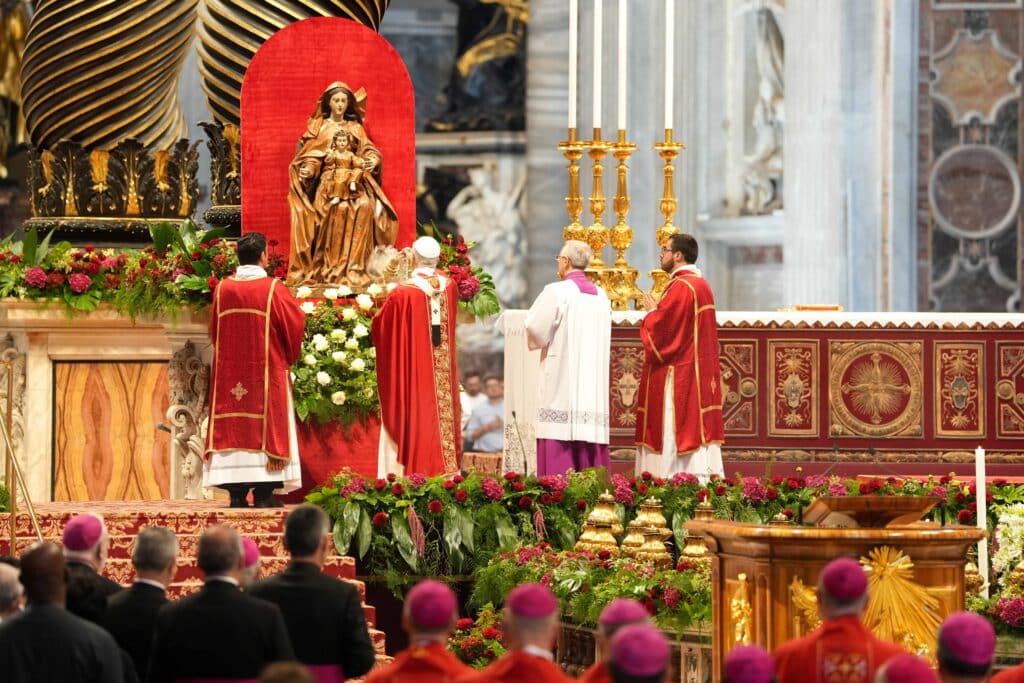
Biggest takeaways
Below are my top twelve takeaways from the responses to CARA’s national Marian survey:
- Mary’s role as “Mother of the Church” is borne out by the fact that a combined 89% of respondents report having a strong devotion (58%) or some devotion (31%) to Mary. Furthermore, 74% report that their devotion to Mary has “strengthened” them (34%) or “very much strengthened” them (41%) in living out their ecclesial vocations.
- Mary clearly has an important role in fostering vocations to the priesthood, diaconate and religious life, with 71% of respondents reporting that they prayed the rosary privately while discerning an ecclesial vocation.
- The impact of Marian apparitions on ecclesial vocations is noteworthy. Clergy and major superiors report that the following approved apparitions had a great or meaningful impact on their original sense of an ecclesial vocation: Fatima (44%), Lourdes (43%) and Guadalupe (31%).
And even though the reported apparitions of Mary at Medjugorje only date back to 1981, the impact of “the spiritual experience of Medjugorje” on ecclesial vocations is also evident. Of the respondents, 14% report that Medjugorje had a great or meaningful impact on their original sense of an ecclesial vocation.
- Given how the Catholic Church in the United States has recently prioritized a Eucharistic revival, it is noteworthy that 80% of respondents indicate that Marian devotion has strengthened their Eucharistic devotion — a finding that reinforces the traditional Catholic mantra, “to Jesus through Mary.”
- St. John Paul II’s promotion of the Marian consecration according to St. Louis de Montfort appears to have had a significant impact, with 44% of all respondents reporting that they have made this kind of Marian consecration.
St. John Paul II and St. Louis de Montfort top the list of saints who have most inspired Marian devotion in respondents’ lives. And these same two saints also finished as the most influential Marian authors among those responding, with St. Louis de Montfort finishing in first place, followed by St. John Paul II.
- Just as Mary’s presence in the Upper Room during the nine days before Pentecost was of great importance to the first bishops of the church (the apostles), so today the bishops of the United States rely greatly on Mary’s maternal presence in their lives.
Of those bishops surveyed, 96% report that they have either a strong devotion or some devotion to Mary, and 68% of bishops report that their devotion to Mary had a great or meaningful impact on their original sense of a vocation to serve Christ and the Church. Of the bishops who responded, 84% report turning to Mary for spiritual assistance very often or often in their ministry.
- Mary has an important role in fostering either conversions to the Catholic Church or “reversions” — that is, individuals who grow up Catholic, fall away, and then return to the church. Among those reporting a conversion or reversion to Catholicism, 71% report that devotion to Mary had an impact on their experience of conversion or reversion.
- The results of this Marian survey make it clear that there is a need for stronger Mariological formation in seminaries, in religious institutes and in permanent deacon formation programs. Almost half of respondents report that their Mariological studies were weak (46%). Deacon directors (64%) and permanent deacons (54%) top the list of those who consider their studies in Mariology to be weak.
- The Rosary continues to hold a place of great importance in the devotional life of Catholic leadership in the United States, with 87% of bishops reporting that they pray the rosary privately, followed by 77% of diocesan priests.
- The domestic church is the most powerful place to cultivate Marian devotion. When asked where their devotion to Mary was fostered, 79% of respondents state that it was in their home, 44% say their parish, and 44% indicate a Catholic school.
- In discerning a vocation to a particular religious community or diocese, religious priests (47%) and women major superiors (36%) top the list of those who say that the Marian dimension of the community they joined was “significant” or “very significant.”
- Whereas the Petrine dimension of the Church (focused, like St. Peter, on action and governance) understandably involves the maintenance of ecclesial unity and, in some cases, uniformity, this survey highlights that the Marian dimension is more about cultural and devotional diversity, with a vast array of Marian titles, Marian works of art and Marian devotions mentioned by respondents.
A source of ‘fruitfulness’ in the Church
Hopefully, the results of this Marian research project will be fruitfully received — not just by clergy, religious and laity in the U.S, but by the universal church.
The Marian dimension and “fruitful receptivity” are closely interwoven, as the future Pope Benedict XVI observes in the book he co-authored with von Balthasar, his friend, titled “Mary: the Church at the Source“: “In today’s intellectual climate, only the masculine principle counts. And that means doing, achieving results, actively planning and producing the world oneself, refusing to wait for anything upon which one would thereby become dependent, relying rather, solely on one’s own abilities. It is, I believe, no coincidence, given our Western, masculine mentality, that we have increasingly separated Christ from his Mother, without grasping that Mary’s motherhood might have some significance for theology and faith. This attitude characterizes our whole approach to the Church.”
Then-Cardinal Ratzinger concludes with a prophetic plea that the church would prioritize “the Marian principle” and follow Mary’s example of being “holy soil”: “The Church is not a manufactured item; she is, rather, the living seed of God that must be allowed to grow and ripen. This is why the Church needs the Marian mystery; this is why the Church herself is a Marian mystery. There can be fruitfulness in the Church only when she has this character, when she becomes holy soil for the Word. We must retrieve the symbol of the fruitful soil; we must once more become waiting, inwardly recollected people who, in the depth of prayer, longing and faith, give the Word room to grow.”

